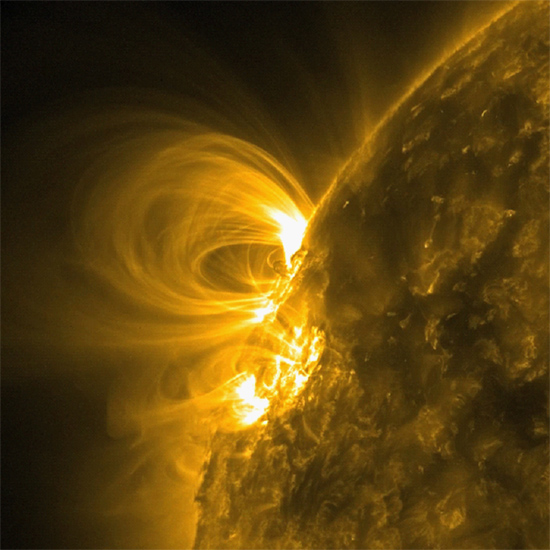Feb 26, 2013
Heliophysicists acknowledge the role of plasma in solar eruptions but miss important aspects of its behavior.
In Bengal to move at all
Is seldom, if ever, done,
But mad dogs and Englishmen
Go out in the midday sun.
— Noël Coward
According to a recent press release, the Sun’s energetic eruptions, known as solar flares, derive their energy from magnetized loops of plasma. The magnetic fields in the “magnetic flux ropes” experience “reconnection events” in which the field lines break and then reconnect, causing explosions of “magnetic energy.”
No one knows what “magnetic reconnection” is; it is a phrase used to describe what is observed but it lacks content. It is similar to the phrase “gravitational attraction”: an unknown phenomenon causes matter to exert attraction over distance but the nature of that attractive force remains obscure. There is another problem with the idea of magnetic field lines breaking. Magnetic field lines are not “things,” they are schematic representations used to plot magnetic fields. They are no more real in space than lines of latitude or longitude are on the surface of the Earth.
Coronal arches and loops rise up from the Sun’s surface and penetrate its plasma sheath, or double layer region. It is there that its primary source of electrical energy resides. Those powerful electric currents form secondary magnetic fields that surround the loop in constrictive toroids. If the current grows too strong, the double layer explodes, interrupting the charge flow. The sudden discharge causes solar flares and gigantic prominence eruptions.
In an Electric Universe based on electrodynamic principles and not electrostatic models, celestial bodies are immersed in plasma and are connected by circuits. The Sun is electrically connected to the galaxy, so it is an unstable charged object seeking equilibrium with its environment. Electric charge flows into the Sun from its galactic circuit, so it is in a constant state of flux.
In 1964, Jacobsen and Carlqvist suggested that double layers caused the release of stored electromagnetic energy on the Sun. That idea was further refined by Alfvén and Carlqvist in 1967. Later, Carlqvist postulated that electric fields could accelerate charged particles with up to 10^14 electron volts per unit charge.
Double layers develop on the Sun as electricity flows through its plasma. Positive charges build up in one region and negative charges build up nearby. An electric field appears between the two regions. If that stored electric charge is catastrophically released, it is known as a “Langmuir burst.” Those explosive bursts are what heliophysicists incorrectly refer to as “magnetic reconnection.”
Stephen Smith













